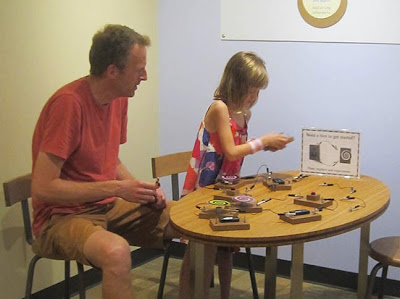The Museum is partnering with Brown University on a major National
Science Foundation-funded project (award #1223777) to study how children
develop scientific thinking skills and understand their own learning
processes. Museum researcher Suzy Letourneau shared this project
update.
Last summer, the Museum opened the new Mind Lab space, which hosts
ongoing research about children’s learning and development by the Museum
and its academic collaborators. When researchers aren’t in the space,
there is a self-directed “circuit block” activity with batteries, motors
and buttons that can be connected in many different configurations. On
the surface the activity is about electricity and circuits, but the
deeper message we hope to convey is the important role of exploration
and experimentation in learning about cause and effect. The activity
draws on scientific research that shows that when children make their
own discoveries about how things work, they explore and learn more
deeply. Thus, we purposefully did not include step-by-step instructions
with the blocks to encourage children to test their ideas and make
discoveries. While prototyping the activity, we found that children
often systematically tried the blocks to see how they worked,
experimented with different ways of making a circuit, and collaborated
or shared their ideas with one another – all evidence of learning.
The exhibits team tested resources for adults to support
children’s thinking as they play, including observation tools and
prompts caregivers can use while playing with their kids (for example,
questions to ask when kids get stuck or aren’t sure how to get
started). Caregivers who tried these resources were more engaged in the
activity themselves, either by observing while their children explored
and made discoveries, or by helping them work through challenges in
different ways. The team also created labels to communicate how
children learn through experience, exploration and play, and offer
research evidence to back up these ideas.
The labels are based on Museum staff’s discussions and knowledge about
the ways that play and exploration support children’s learning and
development, and are informed by conversations with dozens of
caregivers. We asked caregivers what they noticed about their
children’s play, what they thought about how children learn through
play, and what questions they had about these topics. Caregivers often
agreed that kids learned through play, were very interested in research
on children’s learning (including the research that happens at the
Museum), and wanted to learn more.
We created prototype labels and resources using low-cost, temporary
materials so we could get feedback and make changes easily. Some show
specific examples of different ways that children can learn through
play, and others give illustrated summaries of research studies. We
asked visitors: What did the new materials make them think about or
wonder? Which parts were most interesting? Was anything confusing or
unclear?
Based on comments and suggestions, we revised the labels in the fall to
make our messages clearer. We’re also creating more illustrated
research summaries, since they were visitors’ favorites. And we added a
“Guide for Grown-ups” to the circuit block activity to suggest ways that caregivers can support their
children’s learning as they play together. Over the next few months,
Mind Lab will continue to be a site for ongoing research and prototyping
that will help Museum staff learn alongside visitors.
Visit the Museum’s website and see previous blog posts for more information about the Learning About Learning project.



No comments:
Post a Comment